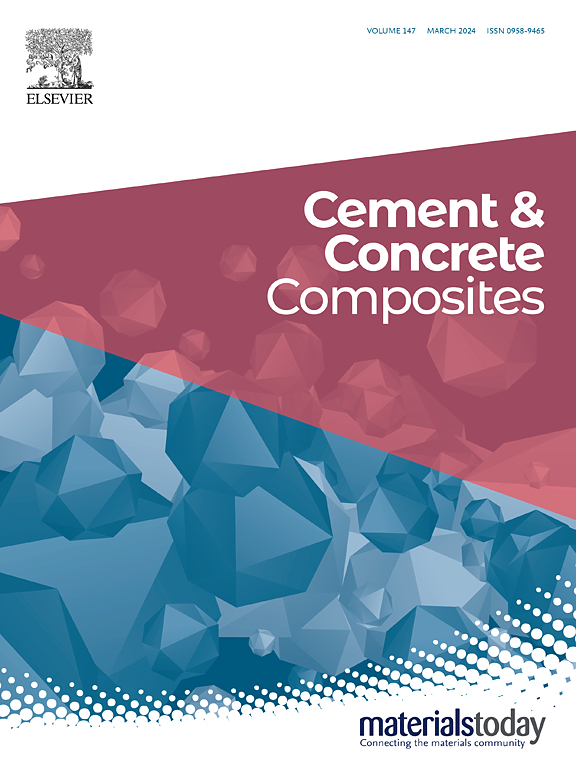Highly activated pozzolanic materials to develop sustainable concrete: a new perspective from photoexcited nano-TiO2
IF 13.1
1区 工程技术
Q1 CONSTRUCTION & BUILDING TECHNOLOGY
引用次数: 0
Abstract
Fly ash, a by-product of coal combustion, is a pozzolanic solid waste with annual production of 1.63 billion tonnes, which has been widely used to replace cement clinker to develop sustainable concrete. However, the incorporation of high volumes of inert fly ash significantly reduces the early mechanical strength of concrete due to its low pozzolanic activity. This study presents an innovative strategy to effectively enhance the reactivity of fly ash by utilizing hydroxyl free radicals (•OH), highly reactive oxidative species generated by nano-TiO2 under UV light excitation. Experimental results demonstrated that photoexcited nano-TiO2 significantly promoted the depolymerization of inert glassy phases in fly ash, resulting in a 28 % increase in Ca(OH)2 consumption within 72 h. Consequently, the compressive and flexural strengths of mortar at 28 days increased by 37 % and 16 %, respectively, with a strength activity index reaching 95.4 %. In addition, the water absorption and chloride ion diffusion coefficient were reduced by 15 % and 18 %, respectively, due to a more refined pore structure driven by enhanced pozzolanic reactivity. Density Functional Theory (DFT) calculations further revealed that •OH substantially lowered the energy barrier for Si-O-Al bonds cleavage (from 22.93 kcal/mol for OH− to 8.54 kcal/mol for •OH), confirming its superior catalytic efficiency and thermodynamic advantage. In conclusion, the findings confirm that photoexcited nano-TiO2 can serve as an effective activator for enhancing the utilization efficiency of fly ash in sustainable concrete.
高活性火山灰材料发展可持续混凝土:光激发纳米tio2的新视角
粉煤灰是煤炭燃烧的副产物,是一种火山灰固体废物,年产量为16.3亿吨,已被广泛用于替代水泥熟料,发展可持续混凝土。然而,由于其低火山灰活性,大量惰性粉煤灰的掺入显著降低了混凝土的早期机械强度。本研究提出了一种创新策略,利用纳米tio2在紫外光激发下产生的高活性氧化物质羟基自由基(•OH)来有效增强粉煤灰的反应性。实验结果表明,光激发纳米tio2显著促进了粉煤灰中惰性玻璃相的解聚,导致72小时内Ca(OH)2的消耗量增加28%。28 d砂浆抗压强度和抗折强度分别提高37%和16%,强度活性指数达到95.4%。此外,由于火山灰活性增强,孔隙结构更加精细,吸水率和氯离子扩散系数分别降低了15%和18%。密度泛函理论(DFT)计算进一步表明,•OH大幅降低了Si-O-Al键裂解的能垒(OH-从22.93 kcal/mol降至8.54 kcal/mol),证实了其优越的催化效率和热力学优势。综上所述,光激发纳米tio2可以作为一种有效的活化剂,提高粉煤灰在可持续混凝土中的利用效率。
本文章由计算机程序翻译,如有差异,请以英文原文为准。
求助全文
约1分钟内获得全文
求助全文
来源期刊

Cement & concrete composites
工程技术-材料科学:复合
CiteScore
18.70
自引率
11.40%
发文量
459
审稿时长
65 days
期刊介绍:
Cement & concrete composites focuses on advancements in cement-concrete composite technology and the production, use, and performance of cement-based construction materials. It covers a wide range of materials, including fiber-reinforced composites, polymer composites, ferrocement, and those incorporating special aggregates or waste materials. Major themes include microstructure, material properties, testing, durability, mechanics, modeling, design, fabrication, and practical applications. The journal welcomes papers on structural behavior, field studies, repair and maintenance, serviceability, and sustainability. It aims to enhance understanding, provide a platform for unconventional materials, promote low-cost energy-saving materials, and bridge the gap between materials science, engineering, and construction. Special issues on emerging topics are also published to encourage collaboration between materials scientists, engineers, designers, and fabricators.
 求助内容:
求助内容: 应助结果提醒方式:
应助结果提醒方式:


